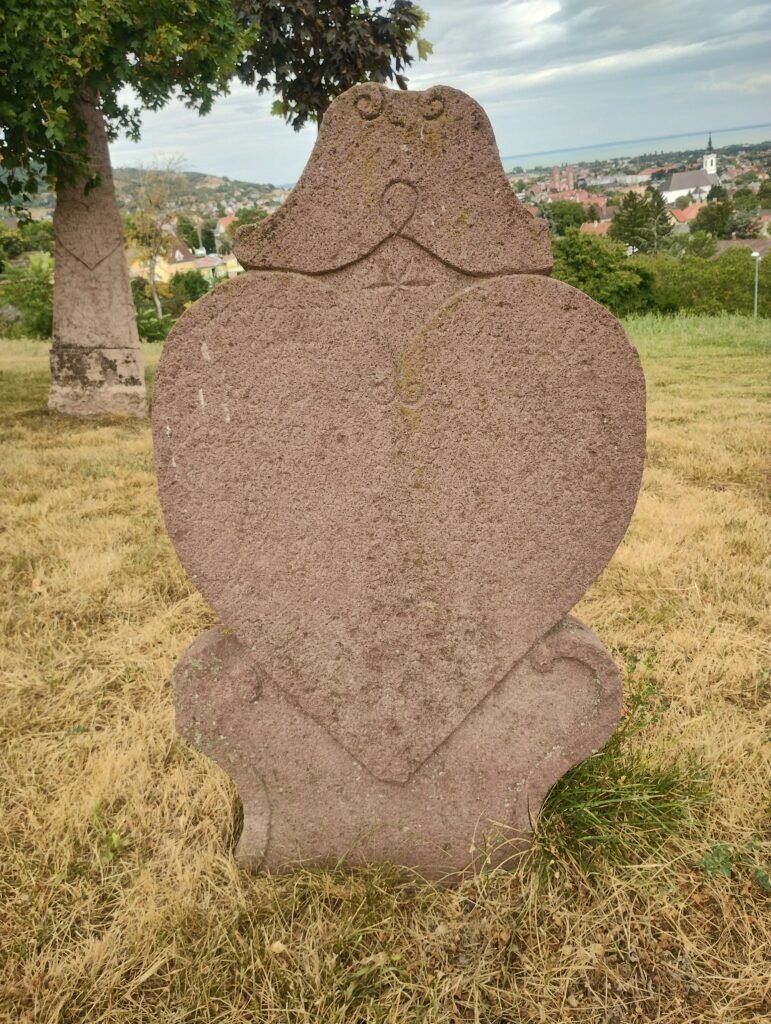


Hungarian artist Szilvia Fekete is someone I greatly admire. I’m a big fan of her work. A while back, she told me about the hearts in the old cemetery in Balatonfüred. Despite my best intentions, I’ve not managed to visit, but my not going shouldn’t deprive you of the experience. Szilvi graciously agreed to share her thoughts and photos with you.
When it comes to heart-shaped tombstones in Hungary, everyone talks only about the cemetery in Balatonudvari. The reason for this is mostly the art of Ilona Keserű, who, as a Hungarian abstract contemporary painter dedicated almost an entire oeuvre of her paintings inspired by the typical shape of these tombstones. I think they are very special and unique but they are not quite heart-shaped.
On the other hand, in the old cemetery of Balatonfüred there are some special and precisely heart-shaped tombstones.
Balatonfüred is the “capital” on the northern shore of Central Eastern Europe’s largest lake, the Balaton. With its bourgeois villas and baths built in the golden age of the Austro-Hungarian Monarchy, it has been one of Hungary’s favourite holiday resorts since the early nineteenth century and it has not lost its popularity to this day.
At the highest point of the town stands the ruins of the old church of Papsoka, which was built in the eleventh/twelfth century on the foundations of a Roman mansion from the fourth century. It was called the Church of St. Michael. Romanesque and Gothic elements can both be discovered in its ruins, next to which burials began in the eighteenth century.
While this old cemetery of Balatonfüred is no longer used as a burial ground, it represents not one, but three cemeteries well divided from each other: Catholic, Protestant, and Jewish (the latter surrounded by a wall). It is an important cultural map in terms of the population and religion of Hungary. The active years of the triple cemetery coincided with the city’s most popular period. The earliest grave in the Jewish cemetery dates from 1810 and the community used it for burials until 1944.
By the way, the word “Protestant” is always debatable in relation to this country; it needs clarification, because it has no exact meaning in the local context. No one really uses this term. The situation in this part of the old continent is completely different from that in Ireland or in the United Kingdom, where when contrasted with the Catholic religion, the word Protestant sums up the practising followers of the Church of Ireland and the Church of England. The doctrines of Martin Luther and then John Calvin first arrived in Roman Catholic Hungary in the sixteenth century. The latter eventually became the second-largest religious minority in Hungary, but the Catholic majority remained. Those who chose one of the “new” paths never called themselves Protestants around here; neither do they do so today. They always specifically refer to their own denomination instead: the two largest religious minorities identify themselves as either református (reformed = Calvinist) or evangélikus (evangelical = Lutheran). The Church of Hungary, as such, does not exist.

In light of this, in the Reformed (Calvinist) section of the three cemeteries, three heart-shaped tombstones can be found. Despite their striking beauty, there is no specific information on the internet about these tombstones, just as we can only speculate about the reason for the shape of the famous Balatonudvari tombstones. But one thing is certain, even if they were made at the same time, the nature of their execution reveals that they were most certainly not carved by the same hands.
Three legends provide a possible explanation for the heart shape of the tombstones in Balatonudvari, one of which is woven around the relationship between death and love. According to this, a young stonemason from the lakeside village of Balatonudvari made the first heart-shaped tombstone for the grave of his love, a fisherman’s daughter, who was lost in the lake.

When seeing heart-shaped tombstones, we can easily think of the interlinked duality of love and death, which was made even more popular by Shakespeare’s Romeo and Juliet following the famous piece in medieval chivalric literature of Tristan and Isolde. These well-known stories are about the power of (even unfulfilled or parental) love that transcends death, the unearthly, eternal connection of two souls. Later, Sigmund Freud approached this complexity from a lot less romantic perspective in one of his essays, dividing male nature into two major parts, Eros and Thanatos, the elements of sexuality, unrestrained libido and death, as a synonym of aggression and destruction.
However, the first, poetic and sentimental point of view, endless love surviving death takes shape in the heart-shaped tombstones of the Balatonfüred cemetery. The tombstones are difficult to read, but they bear witness to the loving memory of conjugal love and family relationships from 1831, 1849, 1852 and in between.
The one that is still most legible today marks the burial place of a man (Under this grave rests ? Mihály Varga lived 66 years died ? April, in 1831), then his son or brother (And NS / VS ? Lajos Varga), and then his wife (and his wife NS ? Lídia Somogyi lived ?8 years, died ? Sept 1852). Unfortunately, the rest of the inscription can no longer be deciphered; the rain and the Balaton wind have washed it away.


When autumn and the Day of the Dead are approaching, the old cemetery in Balatonfüred can be an ideal place for those who like to investigate further the mystery of these wonderfully unique tombstones. The entire area was landscaped and renovated three years ago and the Jewish cemetery can also be visited by prior arrangement. It is definitely worth a trip to think about our unresolved relationship with passing, the love that bonds us for eternity, the anatomy of memory and grief, and so much more.
Szilvia Fekete, Budapest, August 2024